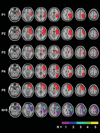Effects of prism adaptation on motor-intentional spatial bias in neglect
- PMID: 21817924
- PMCID: PMC3165096
- DOI: 10.1097/WNR.0b013e32834a3e20
Effects of prism adaptation on motor-intentional spatial bias in neglect
Abstract
Prism adaptation may alleviate some symptoms of spatial neglect. However, the mechanism through which this technique works is still unclear. This study investigated whether prism adaptation differentially affects dysfunction in perceptual-attentional 'where' bias versus motor-intentional 'aiming' bias. Five neglect patients performed a line bisection task in which lines were viewed under both normal and right-left reversed viewing conditions, allowing for the fractionation of 'where' and 'aiming' spatial bias components. After two consecutive days of prism adaptation, participants demonstrated a significant improvement in 'aiming' spatial bias, with no effect on 'where' spatial bias. These findings suggest that prism adaptation may primarily affect motor-intentional 'aiming' bias in poststroke spatial neglect patients.
Figures


References
-
- Barrett AM, Buxbaum LJ, Coslett HB, Edwards E, Heilman KM, Hillis AE, et al. Cognitive rehabilitation interventions for neglect and related disorders: moving from bench to bedside in stroke patients. Journal of cognitive neuroscience. 2006;18:1223–1236. - PubMed
-
- Rossetti Y, Rode G, Pisella L, Farne A, Li L, Boisson D, et al. Prism adaptation to a rightward optical deviation rehabilitates left hemispatial neglect. Nature. 1998;395:166–169. - PubMed
-
- Striemer CL, Danckert J. Dissociating perceptual and motor effects of prism adaptation in neglect. Neuroreport. 2010;21:436–441. - PubMed
Publication types
MeSH terms
Grants and funding
LinkOut - more resources
Full Text Sources

